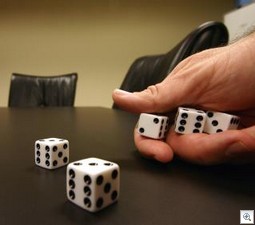 New York has been of great historical importance to gambling. New York being the first state to greet most of the immigrants to the country, New Yorkers saw those immigrants as customers for gambling products. In turn the immigrants became employees and then the entrepreneurs of gambling. Figures such as Jack Morrisey and Richard Canfield developed casinos that became models for later operators. The first horse racetrack in the New World was on Long Island. Racing has continued to be a major gambling activity throughout the state’s history.
New York has been of great historical importance to gambling. New York being the first state to greet most of the immigrants to the country, New Yorkers saw those immigrants as customers for gambling products. In turn the immigrants became employees and then the entrepreneurs of gambling. Figures such as Jack Morrisey and Richard Canfield developed casinos that became models for later operators. The first horse racetrack in the New World was on Long Island. Racing has continued to be a major gambling activity throughout the state’s history.
When gambling moved westward, it moved with New Yorkers. The Louisiana Lottery was run out of New York City. The early founders of the Las Vegas Strip were from New York; prominent latter-day casino developers in both Las Vegas and Atlantic City have New York roots. New York was the second state to create a lottery (1966), the first state to authorize offtrack betting (1971), and the first state to utilize a lotto (progressive jackpot) lottery game (1978).
New York remains an important state for gambling. Although campaigns for commercial casinos have failed repeatedly, the state has excelled in other gambling activity. New York leads the nation in both lottery revenues and revenues from pari-mutuel wagering. The state is the venue supporting several of the nation’s major race tracks – Belmont, Aqueduct, and Saratoga. The state receives more public revenue in terms of actual dollars from gambling than any other state. Historically, and in contemporary times, New York has also led the nation in illegal gambling activity.
Given this history, New York officials were very aware of the activity in Atlantic City after 26 May 1978 when the first legal casino gambling began on the boardwalk. Coincidentally, New York was suffering an economic downturn at the time. Not only did the Atlantic City experience look like one New York could duplicate, but the New Yorkers feared that competition from Atlantic City could have a drastic effect on hotel trade and other tourism in New York City. It was not long before there was a concerted effort to get casinos into the Empire State. There were two big barriers to the campaign for casinos. First, such gambling authorization would require an amendment to the state constitution. That would take a supermajority in two consecutive legislatures, followed by a vote of the people. Second, interests from around the state wanted casinos in their vicinities. Buffalo and Niagara Falls wanted casinos; the Catskills wanted the casinos; so did the Adirondack resort area; and so did several rival locations in the New York City area – the Rockaways, Coney Island, and Manhattan. Legislative representatives could not decide among the communities. Therefore, in 1980 they decided to pass eight different casino amendment bills. Before they could act in 1981, Atty. Gen. Robert Abrams wrote a devastating report on Atlantic City, calling it a failure from every possible angle – crime, social consequences, and economic development. The bills did not get out of committees in 1981. Since 1981 bills have been introduced, and there has been lots of talk about casinos and slot machines here and there. Even with the opening of a Niagara Falls, Ontario, casino, which gained over half of its revenues from New York residents, New York officials have not been able to build a consensus in favor of any casino proposal.
But this does not mean New York has no casinos. The existence of a wide variety of charity gambling, including Las Vegas Nights, meant that the state was required to negotiate with Native American tribes for gambling facilities. The Oneida tribe in the central part of the state actually opened a bingo hall in the early 1970s, before the Seminoles in Florida did so. The Seminoles had the resources to take the controversy over Native gambling through the courts, so they get credit for being the Native gambling pioneers. The Oneidas continued bingo through the 1980s until they negotiated for casino gaming. At first their Turning Stone Casino offered only table games, but now they have over 1,000 machines in the 120,000-square-foot facility. Two other tribes, the Senecas and Mohawks, had bingo games, but there was no other casino until the Mohawks entered into a compact with New York State for a facility in northern New York near the Canadian border. In the early 1990s, the Mohawk site near Massena was the scene of deadly violence as pro- and antigambling factions among the tribe contested gambling decisions, and law enforcement officials from Quebec and New York intervened. They have maintained a sometimes shakey but nevertheless effective peace since then. Plans to open a casino are ongoing in 2001.
<
|
|